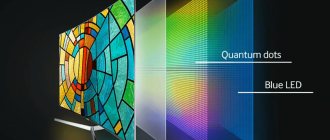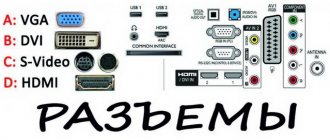One of the most important characteristics of a TV when choosing is the contrast value of the image on the TV screen . If you choose a TV based on picture quality, be sure to pay attention to the contrast value of different models.
By definition, contrast is the ratio of the brightness at the lightest point on the screen to the brightness at the darkest point on the screen. In other words, we divide the white level by the black level and get contrast.
For example, the value 1000:1 is the designation of contrast and it means that the brightness at the light point of the image is 1000 times greater than the brightness at the dark point.
Only the values of these levels can only be obtained through a special test of the TV using specialized instruments. Therefore, the average user has to trust either the manufacturers or various reviews on sites where TVs are tested. Who to trust more and how to check the contrast, and we’ll talk further.
The contrast of panels with self-illuminating pixels is better due to the fact that the pixel can be completely extinguished and the brightness at such a point is almost zero and therefore the black level is good and the contrast has good values. Plasma TVs used to have such panels, which are no longer produced, but today they are OLED models. For OLED TV, the contrast is equated to infinity, so it is not even indicated in the characteristics.
But liquid crystal displays (LCDs) work with backlighting and cannot completely extinguish a pixel, which is why they have problems with contrast. Next we will consider LCD, otherwise LED, televisions and their matrices.
Contrast greatly affects the overall perception of the image. This includes the richness of the picture and color accuracy.
What is TV contrast, its types
A measuring unit for the contrast indicator has not yet been invented, so it is often expressed as the ratio of the lightest (white) point on the screen to the darkest (black). Thus, this value expresses how many times the white point of the screen is brighter than the black point. Let's take 1500:1 as an example. He says that the screen is capable of displaying white color one and a half thousand times brighter than the black color shown on the same screen.
It is almost impossible for a simple user to determine the contrast of a TV with the naked eye, however, information about it can easily be found in the technical data sheet of the device, which is attached to any model, or the seller can tell the seller about its parameters. To test contrast, special high-precision instruments are used.
There are 2 main types of contrast:
- Natural (or static) - its measurement is made at a certain moment - a frozen frame is taken, by comparing the brightest and darkest colors on the screen.
- Dynamic (DC) – its indicator is determined for a moving picture. “Smart” TVs today are able to independently analyze this indicator, which they receive during the broadcast process, and automatically adjust it taking into account the image transmitted on the screen.
Basic selection rules
Investing in a low-quality TV model is tantamount to wasting money. Such a purchase will only leave you with bad emotions, and it won’t be long before you can save up for new equipment. Therefore, it is worth thinking about how to choose the right TV before purchasing it.
The main parameters include:
- Screen type. The matrix, resolution, contrast, brightness, frequency and response time are important.
- Designer design. In addition to flat panels, there are semicircular TVs, options with a bright rim or original backlighting.
- Sound quality and the presence of a stereo system affect the perception of films. But it can be improved with good speakers and subwoofers.
- Type of operating system for Smart TV. Availability of a convenient interface and additional options.
Additional criteria include the presence of the required number of connectors for connecting equipment. As well as the manufacturer, cost and warranty. Price is an important, but not the most important factor when choosing the right TV for your home.
Let's look at each criterion in detail.
Which TV contrast is better?
The ability of modern TVs to automatically adjust contrast is undoubtedly a rather convenient and useful feature, however, for most models, the resulting result is undoubtedly far from what commercials promise the consumer. However, if we talk about the image quality of modern LCD panels in general, then they, of course, benefit in comparison with older generation TVs.
And yet, it should be noted that screens with a high static contrast ratio are valued more highly due to the high quality of the image they transmit.
Such image quality, as close to real as possible, at one time could be broadcast by kinescopes of tube televisions. Today, among the limitless abundance of manufacturers and models, the undoubted leaders in the quality of the transmitted picture in terms of the ratio of white and black are:
- How is the brightness of a monitor and TV screen measured?
- JVC company, which uses D-ILA technology in its production.
- SONY brand devices produced on the basis of SXRD technology.
- New generation devices with plasma screens.
LCD TVs have recently increasingly used backlighting using LEDs with local dimming. This, in turn, contributes to the fact that the contrast ratio of such TVs is much higher than that of models created using other technologies. However, due to the fact that the use of such production technology requires quite high costs, the backlight of the screen is not full, but side-lit. Plasma TVs have full matrix backlighting, so the quality of image transmission is many times higher than that of LCDs. True, they cost much more because of this.
New improvement technologies
LCD TV manufacturers have introduced several technologies in recent years to achieve high contrast levels.
The best results in increasing contrast are achieved by using LED backlighting with local dimming. In this case, it is impossible to adjust the backlight of each pixel and each LED is not controlled individually; the backlight is adjusted by zone. But still the result is good. There can be tens or hundreds of such zones, and with the use of miniLED backlighting, there can be thousands of zones.
Today, the so-called edge lighting is mainly used. Local dimming schemes have also been developed for side lighting. TVs with such backlighting show fairly good results in terms of contrast.
The best results for backlight control are shown by full arrays of FALD LEDs.
What do contrast ratios of 1200, 3000 and 5000 mean?
Let's take, for example, the indicator 1200. It characterizes the picture on the screen as an image of rather low quality, typical for inexpensive TV models. It follows from this that the brightest place on the screen is 1200 times different from the darkest place on it. Indicators of 3000 and 5000 indicate the same thing. The difference between these three indicators, in this case, lies precisely in the magnitude of the coefficient, in the very “number of times” that distinguishes white from black - the higher this coefficient, the better quality the picture on the screen will be.
An indicator of 3000 is also evidence of a picture of not very high quality. Yes, it is undoubtedly better than 1200, but it is still very far from perfect. The figure of 5000 and above is typical for TVs belonging to the middle price category. For expensive models, the contrast ratio starts at approximately 20,000:1.
Based on all of the above, we can conclude that there is no exact answer to the question: “Which TV contrast is better?” It's almost impossible to give. Because how well the image is transmitted depends not only on this indicator, but also on the conditions under which the broadcast is made. Therefore, when you buy yourself a new TV, take the time to customize it for yourself. Remember, the device’s factory settings are not suitable for everyone, as image quality may be significantly lost. At the same time, do not forget that some models are capable of independently adjusting the contrast level independently, depending on the location of the device, the level of illumination in the room and the time of day of its operation.
TVContent
With each new model released, TV manufacturers announce its improved properties and functions. One of these parameters is the contrast of the TV. Its various types, advantages and disadvantages are difficult for the average buyer of equipment to perceive, and therefore it is important to find out how important it is when viewing, and which type is preferable.
Diagonal and screen resolution
Modern TVs come with diagonals from 20 to 98 inches. It is difficult to give advice on what size device you should buy for the kitchen, bedroom or living room. The choice of diagonal directly depends on the distance at which they plan to watch TV and the financial capabilities of the buyer.
Along with the diagonal is the screen resolution. There are four types on the market today:
- HD (1366 x 768) is the basis of digital television broadcasting. It remains the lot of the most budget models with a diagonal of up to 30 inches;
- FHD (1920 x 1080) - a gradually disappearing format with good image quality and a lot of content;
- UHD (4K, 3840 x 2160) - has a higher quality picture and a low barrier to entry. If on TVs with a diagonal of up to 45 inches there is still parity in resolutions (FHD and UHD), then, starting from 50 inches, 4K reigns supreme;
- 8K UHD (8K, 7680 × 4320) is the prerogative of sophisticated users. There is practically no content yet. Although 8K TVs can programmatically scale images up to 4320p, it is not clear whether the game is worth the candle in terms of the money spent. And the combination of 8K with organic LEDs is comparable in cost to a good car.
The higher the resolution, the smaller the pixel size and the more detailed the picture will be, and, therefore, the shorter the distance at which we will get a high-quality image without grain.
For example, for a 40-inch FHD TV this distance is about 2 m, and for a 4K TV of the same size it is about 1 m. However, this does not mean that you need to look at a high-resolution TV point-blank. From a medical point of view, the distance from the TV to a person should be at least three diagonals of the panel.
Dolby vs DTS
Half the success of a good film is its soundtrack. The two most popular audio formats are DTS and Dolby . Both support six-channel surround sound (a five-speaker system with a subwoofer). The main difference between them is the bitrate. For example, for Blu-ray discs, Dolby technology compresses audio to 640 Kbps, while DTS bitrates are up to 1.5 Mbps. In theory, less compression during encoding means more detailed audio. So, let's choose DTS? Not so fast. Dolby claims that its codecs and compression algorithms are more efficient, and the sound is not inferior to its competitor. However, modern TVs often have both technologies at the same time.
The most advanced versions of these audio formats are DTS:X and Dolby Atmos . They support eight-channel (7.1) surround sound, and therefore more accurately and realistically recreate various sound effects (for example, the noise of a helicopter flying overhead or the flight of a bullet).
Dolby Atmos uses additional speakers. Ideally, they are placed on the ceiling to create a sound “bubble”. Don't want to drill into the ceiling with a hammer drill? You can buy Dolby Atmos sound bars with special drivers that create a similar effect. Premium models from all well-known manufacturers have Dolby Atmos support. This format is found on Blu-ray Discs and streaming services including Amazon Prime Video and Netflix.
DTS:X is more flexible. It works with standard driver settings and does not require additional speakers. You can manually adjust audio tracks, allowing you to, for example, bring out an actor's voice above loud special effects. DTS:X support can be added by the TV manufacturer through a firmware update. In terms of content, it's a less common format: neither Netflix nor AppleTV+ currently support it.
With rare exceptions, modern TVs cannot boast of powerful acoustics, so movie buffs should consider purchasing a good additional audio system. These could be regular speakers, a sound bar or a home theater.
Screen refresh rate
The screen refresh rate is the maximum number of frames per second that can be displayed. Broadcasting usually does not exceed 50 frames, and films generally 24. To make the picture smoother, the processors of modern TVs “complete” intermediate frames (interpolation technology). However, these algorithms are not flawless; in scenes with multidirectional fast movement, artifacts may appear. Secondly, such “improvements” can make old films seem too smooth and real, which is not always pleasant for the viewer.
TVs have a screen refresh rate of 50/60 or 100/120 Hz. At one time, this parameter gave rise to a lot of marketing manipulations. Sometimes you could find TVs with a frequency of 800, 1200 and even 1600 Hz!
A little history. Previously, the coveted numbers were obtained by multiplying the refresh rate by the number of LED backlight flashes. For example, 100 Hz of the screen, multiplied by 10, gave the whole 1000. Manufacturers used various indices and names to indicate this parameter. After the advent of new matrices with frame changes in milliseconds and powerful processors, the carousel with marketing frequency measurements almost stopped, and TVs finally received “honest” 50/60 and 100/120 Hz.
Theoretically, a TV with a 120Hz refresh rate will give a smoother and more detailed picture compared to a 60Hz model. This will be especially noticeable in dynamic scenes and console games. However, in practice the difference is not always present, and the higher the frame rate of the source video, the less visible the differences will be. As a rule, 120 Hz TVs are premium models and cost significantly more.
HDR
HDR technology (high dynamic range) makes the picture as rich, vibrant and realistic as possible. Most modern 4K TVs support HDR by default. At the same time, the capabilities of budget devices may be very far from perfect. True HDR is guaranteed by the “ULTRA HD Premium” and “4K HDR” logos on the TV box.
For ideal implementation of the technology, a 10-bit matrix, peak brightness of 1000 nits, high contrast, local backlighting, and HDMA 2.0 connectors are required.
The stumbling block may be the lack of HDR content. So far, HDR is supported by some films and TV series on streaming services, UHD Blu-ray discs, and some modern console games.
There are several main HDR formats: HDR10, HDR10+, Dolby Vision, HLG . To find out what format your TV supports, it's best to look at the manufacturer's specifications. Often in one model there are two or three types of HDR at once. This technology is described in detail in the article “What is HDR on TV.”
What is the difference from a regular diode?
It turns out that a light diode is still different from a conventional (signal) diode. The main difference, of course, lies in the design. Thus, the LED has a special hemispherical protection that protects it from shocks and other mechanical influences from the outside. Also very interesting is the fact that the LED junction itself emits quite a few photons. It is for this reason that the LED housing is specially made of epoxy resin, which allows photons going in other directions to be directed straight up.
Sometimes there are very unusual forms of LEDs. Among them are rectangular, cylindrical and even arrow-shaped. It all depends on where the light needs to be concentrated, and this depends on the purpose for which this LED is created.
Smart TV and various operating systems
If you want a little more from your TV than watching the news and Field of Miracles on Fridays, you should look towards smart models. However, TVs without Smart TV remain only among the most budget devices. Smart TV makes it possible to listen to music and watch videos online, communicate on social networks, and play. Of course, for Smart TV to function, you need a constant connection to the Internet.
Tizen with AppleTV
There are many operating systems that power smart TVs.
- Linux is a closed OS for budget models from SONY, Philips, Panasonic and other companies. Closedness means a limited set of applications preinstalled by the manufacturer, which cannot be changed.
- Android TV is a Google-certified version of the OS designed exclusively for TVs and set-top boxes. The apps and games in the Android TV store are fully optimized for TVs. Used by SONY, Philips and TCL. Not as fast as branded shells, but has a richer selection of applications.
- Android AOSP (Android Open Source Project) is a regular Android installed on a TV. Gives more freedom to install various programs, but there is no guarantee of their compatibility with the TV. The disadvantage is also the low optimization for working with the remote control and voice assistant.
- Many key manufacturers have their own OS: Tizen - Samsung's proprietary OS, WebOS - LG, VIDAA - Hisense, My Home Screen - Panasonic, HarmonyOS - Huawei and Honor.
- AppleTV is a set-top box from Cupertino that gives access to Apple branded services. Some TV manufacturers have recently started integrating AppleTV into their shells.
WebOS
Large companies provide support for several years after the release of a model, sending minor and major updates. If the TV connects to the network automatically, the user should simply receive a request to update the firmware.
Ports and switching
Modern devices have many connectors. Let's look at the most relevant ones.
HDMI is perhaps the main port of any TV. If you plan to send UHD content from a PC, player or game console to your TV, it must have HDMI ports version 2.0 and higher. Outdated HDMA 1.4 does not allow transmission of 60-frame 4K video with a multi-channel audio track. If the TV will be hanging on a bracket close to the wall, it is better to take a model with side ports - this will make it easier to get to them. For an ordinary user, 2-3 HDMI will be enough (for a console, player, PC).
Side ports and USB 3
USB - with its help you can connect storage devices (flash drives or external hard drives) with movies, photos and even music to the TV. To view 4K content, the bandwidth of the old revision 2.0 may not be enough, especially if the buffer becomes clogged. Therefore, it is better to choose TVs with more modern USB 3.0.
Optical port (S/PDIF) - required for connecting advanced speaker systems to the TV: some speakers, sound bars, home theaters. Most modern models are equipped with it. If there is no optical port, you can use a 3.5 mm jack or RCA.
Ethernet (RJ-45, LAN) is a reliable and fast way to wire a TV to the Internet. This makes it possible to “surf”, watch videos and use streaming services on the big screen. If at the repair stage the proper placement of a special “Internet socket” was not thought out, you will have to pull extra wires. To avoid this, manufacturers install Wi-Fi modules in TVs.
Wi-Fi module - needed for wireless connection to the Internet. A high-quality router will provide your TV with a wide channel for receiving and broadcasting UHD content.
Bluetooth module - used to wirelessly connect various BT peripherals to the TV: keyboard, mouse, headphones, speakers. It also allows you to directly control your TV from your smartphone or tablet. It occurs quite often in modern models.
Image Settings
Each new TV comes with a technical data sheet with detailed specifications and an instruction manual for the model you have chosen. There you will find a section on the image settings that were selected when testing the TV. But this does not mean that they will be the best for you. Therefore, when setting up your TV, consider your personal wishes.
Brightness setting
The brightness setting is responsible for the black level of the image, its brightness and intensity. If you set the brightness too high, all black colors will turn gray and the image will lose clarity.
There are two ways to adjust the brightness on your TV.
You can adjust the brightness by eye. To do this, you need to select an image in the film with black tones and shadows and stop at this frame. When adjusted, the black intensity will increase and the shadow will become darker. You'll get the best brightness settings when true blacks appear black and other blacks appear grayer. If you adjust your image below this value, you may lose detail in the shadows. Adjust the brightness level that is optimal for you.
The second method is more accurate. When adjusting the image, a special image is used. When adjusting the picture, you need to increase the brightness level so that you can clearly see all the stripes, and then reduce it until the left stripe matches the background.
Adjusting Contrast
The contrast setting is responsible for the white level of the image, that is, it controls the saturation of the brightest moments in the frame.
To adjust the contrast, you need to find and display a frame that has bright white details, for example with snow against the sky on a sunny day. With a low contrast setting, the snow will appear light gray. As the contrast increases, the snow will turn white and there will come a point when the image begins to lose detail, which means that the optimal point has been passed. Find the point where the image appears white while still maintaining structure and detail. This is the optimal point of contrast. It is better to adjust the brightness in a darkened room.
Color Setting
Color is responsible for the saturation of colors in an image. If you reduce the color to a minimum, the picture will look black and white, if you increase it to the maximum, the picture will become unnatural, for example, grass with a saturated color can turn poisonous green.
To adjust the color, it is best to choose a picture of a natural landscape with green foliage and blue sky, or open a photo and adjust the color based on people’s faces.
Adjusting the Color Tone
Hue adjusts color balance. You can adjust the tone using a picture of a person. As the color tone level increases, human skin becomes green, and as it decreases, it turns purple. The middle is near the center of the scale, where the flesh tone looks natural.
Sharpness adjustment
Sharpening makes details in an image more visible. It artificially highlights the edges and makes the image less natural. By reducing sharpening, you'll get a smoother, more natural image with less clutter and artificial sharpening noise.











